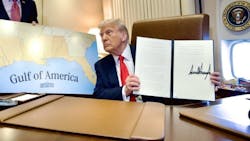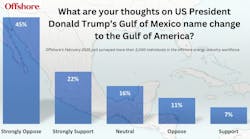Trump reaffirms commitment to ‘Gulf of America’ name change
By Bruce Beaubouef, Managing Editor
On his flight into New Orleans on Feb. 9, President Trump reaffirmed his earlier commitment to rename the US portion of the Gulf of Mexico to the “Gulf of America.”
-
Pre-2025: The body of water was universally known as the Gulf of Mexico.
-
Jan. 20, 2025: On his Inauguration Day, Donald Trump signed an executive order to rename the Gulf of Mexico to the Gulf of America.
- Jan. 23, 2025: The Associated Press states it will refer to the Gulf of Mexico by its original name while acknowledging the new name Trump has chosen.
-
Feb. 9, 2025: Secretary of the Interior Doug Burgum announced the official name change and Trump declared this "Gulf of America Day."
-
Feb. 11, 2025: Google Maps updated its platform to reflect the new name, Gulf of America, for US users only.
On that flight, the president signed a proclamation declaring Feb. 9 as “Gulf of America Day” as he flew over the renamed body of water on his way to attend Super Bowl LIX in New Orleans.
“I took this action in part because, as stated in that Order, ‘[t]he area formerly known as the Gulf of Mexico has long been an integral asset to our once burgeoning Nation and has remained an indelible part of America,’” Trump said.
On his first day in office, Trump issued an executive order that directed the secretary of the Interior to rename the body of water as the Gulf of America within 30 days.
That executive order said: “The Gulf will continue to play a pivotal role in shaping America's future and the global economy, and in recognition of this flourishing economic resource and its critical importance to our Nation's economy and its people, I am directing that it officially be renamed the Gulf of America.”
The Gulf borders some 1,700 miles of US coastline spanning Texas, Louisiana, Mississippi, Alabama and Florida, as well as parts of Cuba and Mexico. Its oil and gas reserves, fisheries, ports and tourism opportunities make it a valuable resource in many ways.
Questions about the name change persist
The executive order will dictate how the federal government refers to the body of water, and a number of offices within the federal government have begun to make the switch.
But even as the federal government implements the switch, questions persist about how it will work and who must comply. Whether private institutions – such as mapping platforms, media outlets, educational companies, and offshore E&P companies – follow suit remains to be seen.
The Gulf of Mexico has had many names throughout history, including:
- Gulf of Mexico: This name first appeared in print in 1552 and on a world map in 1550. It has been the most common name since the mid-17th century.
- Golfo de Nueva España: This name was used by Spanish explorers in the 16th century.
- Golphe da Mexique: This name was used by French Jesuits in 1672.
- The Great Bay of Mexico: This name appeared on an English nautical chart in 1700.
- The Bay of Mexico: This name appeared on an English nautical chart in 1775.
- Mexican Cove/Mexican Sound: This name was used by Spanish admiralty charts in the 18th century.
Some, like Google, have announced plans to start calling it the Gulf of America, at least in the United States. Others, like the Associated Press, plan to keep the original name. It is possible that some maps will eventually include both — as is the case for some other bodies of water around the world.
The US Department of the Interior has said that the US Board on Geographic Names will comply with Trump’s order. According to the order, the renaming process involves updating the Geographic Names Information System (GNIS), the official federal database of all US geographic names, to reflect the change and “remove all references to the Gulf of Mexico.”
The order also instructs the US Board on Geographic Names — a federal agency within the Department of Interior that standardizes geographic names for government use — to ensure the change is reflected in agency maps, contracts, documents and communications.
“The US Board on Geographic Names, under the purview of the Department of the Interior, is working expeditiously to update the official federal nomenclature in the Geographic Names Information System to reflect these changes, effective immediately for federal use,” the DOI announced in late January.
A number of institutions, organizations and public officials quickly adopted the new nomenclature. On Jan. 20, Florida Governor Ron DeSantis referred to the Gulf of Mexico as the “Gulf of America” in a state executive order describing a brewing winter storm heading for the Florida Panhandle.
Also in January, the National Weather Service’s Storm Prediction Center began using “Gulf of America” in its public forecasts, though the “Gulf of Mexico” still appears in some places on the weather service’s website.
Chevron, a major player in Gulf E&P, used “Gulf of America” repeatedly in its quarterly earnings report released in late January following Trump’s executive order.
Google made headlines by announcing it will update Google Maps as soon as the name is changed in official government sources, in accordance with its “longstanding practice.” The name change will only apply to users in the US, Google added. Users in Mexico will continue to see “Gulf of Mexico.”
How is Mexico responding?
Mexican President Claudia Sheinbaum has issued a number of objections to Trump’s order. As reported by NPR, when Trump raised the idea in early January, Sheinbaum retorted that North America be renamed “América Mexicana,” or “Mexican America,” referencing a phrase from a 19th-century document.
“For us, it is still the Gulf of Mexico, and for the entire world, it is still the Gulf of Mexico,” she said, according to the Associated Press, adding that it has had that name since 1607. But she was quick to criticize Google in early February after the company announced its plans to conform with Trump’s order.
At a recent press conference, Sheinbaum showed reporters a copy of a letter she sent to Google in which she argued that the US cannot unilaterally rename the Gulf. She cited the United Nations Convention on the Law of the Sea, which says a country’s territorial sovereignty only extends 12 nautical miles from its coastline.
“If a country wants to change the designation of something in the sea, it would only apply up to 12 nautical miles. It cannot apply to the rest, in this case, the Gulf of Mexico,” Sheinbaum said. “This is what we explained in detail to Google.”
Other body of water disputes
The Gulf of Mexico is far from the only contentious body of water in the world. Several have different names in different countries, reflecting territorial disputes or broader geopolitical tensions.
One famous example is the body of water south of China, which much of the world calls the South China Sea. Neighboring Asian countries — who claim parts of it — use different terminology: China calls it the South Sea, Vietnam calls it the Eastern Sea and the Philippines has designated parts of it as the West Philippine Sea.
Another prominent example is the body of water that separates the Arabian Peninsula from Iran. It has long been known as the Persian Gulf and is still called that in much of the world. But Arab nations in the region call it the Arabian Gulf.
There is also a naming dispute over what is widely known as the Sea of Japan — but referred to as the East Sea by neighboring North and South Korea.
Our stance
As for Offshore, we recognize that the offshore energy arena has seen a whirlwind of seemingly constant change over the past few years. As always, we remain flexible and pragmatic, with the main goal of always meeting our readers’ needs. Sometimes, that requires change. But for the present, we will continue to use the term “Gulf of Mexico” for both the US and Mexican offshore energy regions, using the terms “US Gulf of Mexico” and “Mexican Gulf of Mexico” or “offshore Mexico” when we need to be more specific.
In short, for the foreseeable future at least, we will keep doing what we have been doing.
Oil and gas operations have been ongoing in what has been described as the “Gulf of Mexico” since 1947 – nearly 80 years now. During those eight decades, the US Gulf became the world’s leading offshore oil-producing province in terms of technology, innovation, and production. Offshore has been covering this market for 70 of those 78 years. We don’t recall anyone having any objection to thinking of this region as “the Gulf of Mexico” in all those years.
There are other considerations as well. Offshore started out as a (US) Gulf of Mexico trade publication back in 1954, and the bulk of our readers resided along the US Gulf Coast. Those readers are still far and away the largest single group in our audience.
But Offshore has grown considerably since then, and we now also have a very sizable international audience to consider. Those readers might be confused by the name change; or alternatively, might not officially recognize it.
In all our articles, news updates, and messaging, we seek to provide clarity and wording that everyone can understand. It may very well turn out that only government offices and map-making agencies adopt the “Gulf of America” labeling. And who knows what succeeding presidential administrations will do?
That’s not to say that we are impervious and unyielding to change. Indeed, Offshore’s editorial coverage has seen significant change over the past few years. As always, we know we have to adapt—what we cover, how we cover it, and in what medium we distribute that information.
If the “Gulf of America” takes on momentum within the major offshore operating companies, independent producers, and the contractors, vendors and suppliers that serve the offshore market, we will revisit our position on this.
But for now, we’re siding with tradition and history, and we’re sticking with “the Gulf of Mexico.”
March 3, 2025 update:
Offshore polled its readers about their thoughts on Trump's recent executive order to change the Gulf of Mexico name to Gulf of America. The poll ran from Feb. 12 to March 2. Of the 3,092 poll respondents, 56% of our audience opposes the new name. Check out the article below to see the full poll results.
About the Author
Bruce Beaubouef
Managing Editor
Bruce Beaubouef is Managing Editor for Offshore magazine. In that capacity, he plans and oversees content for the magazine; writes features on technologies and trends for the magazine; writes news updates for the website; creates and moderates topical webinars; and creates videos that focus on offshore oil and gas and renewable energies. Beaubouef has been in the oil and gas trade media for 25 years, starting out as Editor of Hart’s Pipeline Digest in 1998. From there, he went on to serve as Associate Editor for Pipe Line and Gas Industry for Gulf Publishing for four years before rejoining Hart Publications as Editor of PipeLine and Gas Technology in 2003. He joined Offshore magazine as Managing Editor in 2010, at that time owned by PennWell Corp. Beaubouef earned his Ph.D. at the University of Houston in 1997, and his dissertation was published in book form by Texas A&M University Press in September 2007 as The Strategic Petroleum Reserve: U.S. Energy Security and Oil Politics, 1975-2005.


